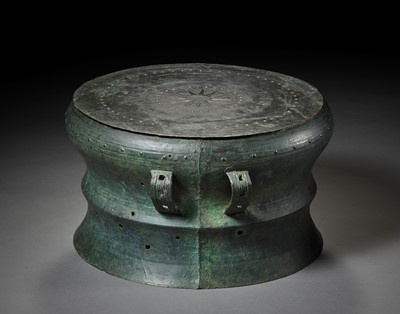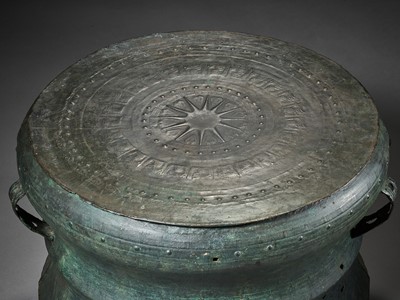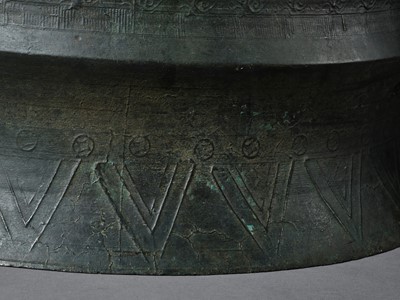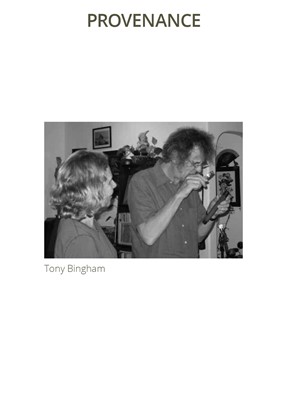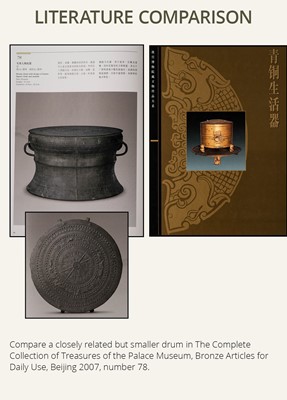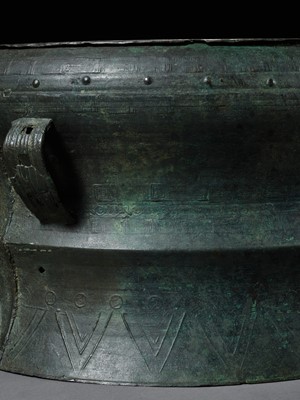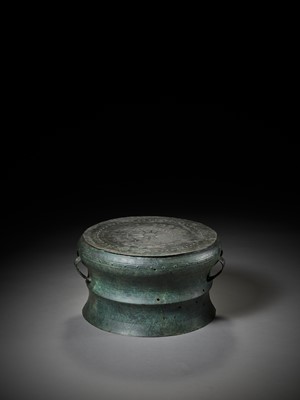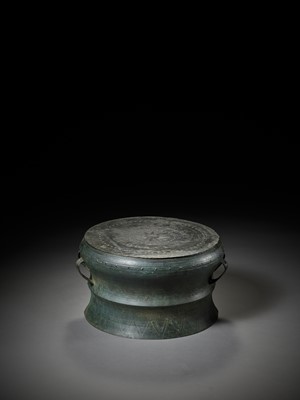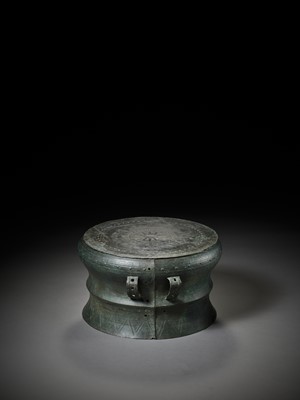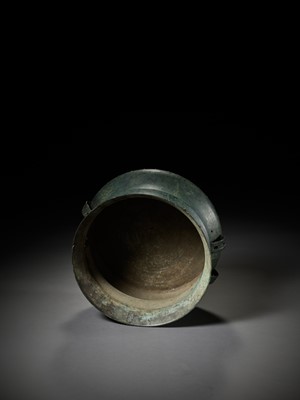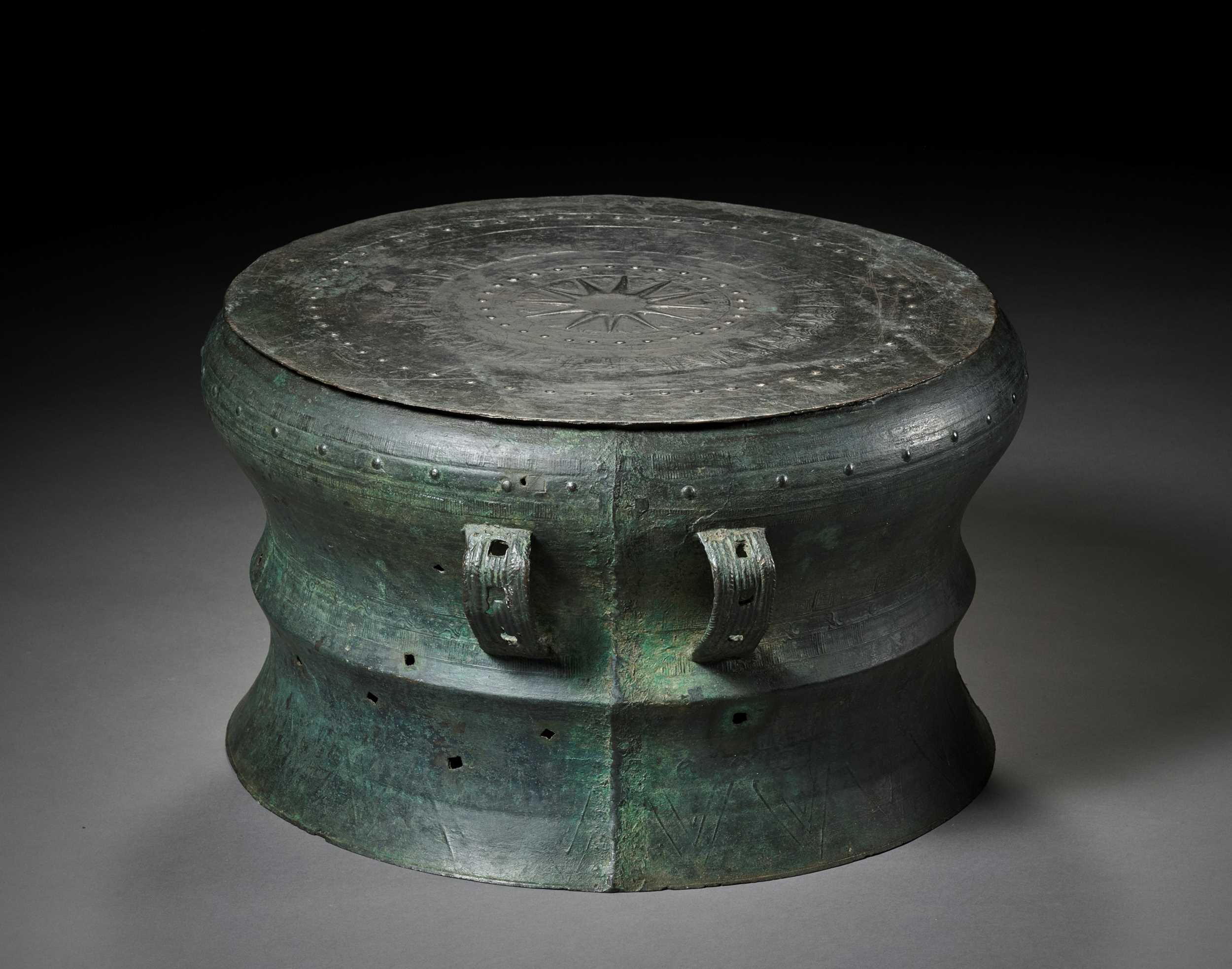29th Sep, 2022 13:00
DAY 1 - TWO-DAY AUCTION - Fine Chinese Art / 中國藝術集珍 / Buddhism & Hinduism
265
A BRONZE DRUM, HAN DYNASTY
漢代青銅鼓
Sold for €7,800
including Buyer's Premium
China, 202 BC – 220 AD. The round drum supported on a waisted base, the top and sides finely cast in relief with multiple concentric geometric designs including key-fret, triangles, and beads centered by a star design, with pairs of loop handles to either side. The drum produces a clear and distinct sound.
Provenance: From the collection of Tony Bingham, United Kingdom. Tony Bingham is a retired dealer of antique musical instruments. He and his wife Irene opened several stores in London beginning in the 1960s, where they were selling antique instruments to museums, private collectors, and musicians, for more than 40 years. He also published several books on the history of musical instruments, including The New Langwill Index, a Dictionary of Musical Wind-Instrument Makers and Inventors.
Condition: Good condition commensurate with age showing extensive wear and weathering, some casting flaws, possibly minor old repairs, small losses, nicks, dents, and scratches. Fine, naturally grown patina with Malachite encrustations. All as expected from a bronze drum with an age of roughly two millennia.
Weight: 16.4 kg
Dimensions: Height 29.4 cm, Diameter 51.5 cm
Expert's note: Bronze drums such as the present lot are a percussion instrument used by various ethnic groups from the southwest of China. They were popular in Yunnan, Guizhou, Sichuan and Hunan Provinces, among which Yunnan and Guangxi have the largest numbers recorded. Both provinces share a border with Vietnam, home to the Dong Son culture, which in turn is well-known for its own drums. Applied to sacrifice rituals, the drums were usually used to play music or accompany dance rites.
The Yunnan Provincial Museum in Kunming houses an important collection of early bronze drums (Warring States through Western Han period) that were excavated from royal burials at Shizhai Shan and other locations in the vicinity of Lake Dian. This part of Yunnan, whose people and language were not originally Han Chinese, had been ruled by the independent Dian kingdom from about 500 BC. Bronzes from this period through the middle Western Han Dynasty (about 100 BC) are unique to the region, and share many characteristics with bronze artifacts of Southeast Asia. Their decoration was also influenced by artistic styles of the Eurasian steppe.
After surrendering to Han Wudi in 109 BC, the Dian kingdom was administered as a frontier commandery of the Han empire. Dian kings were retained as local rulers. From then on, the distinctive Dian regional bronzes became gradually replaced by Han-style bronzes, in the type of cultural assimilation that is called "Sinification" (literally, "becoming Chinese") by Chinese historians.
Literature comparison:
Compare a closely related but smaller drum in The Complete Collection of Treasures of the Palace Museum, Bronze Articles for Daily Use, Beijing 2007, number 78.
漢代青銅鼓
中國,公元前202年至公元220年。圓鼓,由鼓面向下收後,足部外撇,腰部有明顯凸起的弦紋。鼓面有雙圈十二角星紋,外壁飾有雷紋、三角紋、凸起鉚釘等幾何紋飾。兩側各有一對環形把手。該鼓發出的聲音清晰響亮。
來源:英國Tony Bingham收藏。Tony Bingham是一位退休的古董樂器經銷商。他和其妻子Irene於1960年代初期,在倫敦開設了多間古董樂器行,並出售給博物館、私人收藏家和音樂家,營業40餘年。他也出版了多本關於樂器史的書籍,其中包括《The New Langwill Index, a Dictionary of Musical Wind-Instrument Makers and Inventors》。
品相:品相良好,與年代相稱的大面積磨損、風化,有些鑄造瑕疵和可能的舊修補,小缺損、刻痕、凹痕和劃痕。良好和自然生長的包漿,帶有孔雀綠色結殼。這些狀況都是在一件兩千年前的青銅鼓上可預期的。
重量:16.4公斤
尺寸:高29.4厘米,直徑51.5厘米
專家注釋:此類型的青銅鼓是中國西南地區各民族使用的一種打擊樂器。它們流行於雲南、貴州、四川和湖南等省,其中雲南和廣西所記錄數量最多。這兩個省都與越南接壤,越南是東山文化的發源地,而東山文化又以鼓而聞名。鼓通常被用於祭祀儀式,演奏音樂或伴舞。
昆明的雲南省博物館收藏了一批重要的早期青銅鼓(戰國至西漢時期),這些銅鼓出土於石寨山和滇池附近的皇家墓葬中。雲南地區的人民和語言與漢族不同,自公元前500年起,就被獨立的滇國所統治。直到西漢中期(約公元前100年),此地區的青銅器都是獨有的,與東南亞的青銅器有許多共同特點。它們的裝飾也受到了歐亞草原藝術風格的影響。
公元前109年,滇國投降漢武帝後,漢朝在此設立益州郡,滇王則被任命為益州太守。自此,獨特的滇族地區青銅器逐漸被漢族風格的青銅器所取代,這種文化同化的過程被中國歷史學家稱為 "漢化"。
文獻比較:
比較一件非常相近但尺寸較小的青銅鼓,見《故宮博物院藏文物珍品全集‧青銅生活器》,北京,2007年,編號78。
China, 202 BC – 220 AD. The round drum supported on a waisted base, the top and sides finely cast in relief with multiple concentric geometric designs including key-fret, triangles, and beads centered by a star design, with pairs of loop handles to either side. The drum produces a clear and distinct sound.
Provenance: From the collection of Tony Bingham, United Kingdom. Tony Bingham is a retired dealer of antique musical instruments. He and his wife Irene opened several stores in London beginning in the 1960s, where they were selling antique instruments to museums, private collectors, and musicians, for more than 40 years. He also published several books on the history of musical instruments, including The New Langwill Index, a Dictionary of Musical Wind-Instrument Makers and Inventors.
Condition: Good condition commensurate with age showing extensive wear and weathering, some casting flaws, possibly minor old repairs, small losses, nicks, dents, and scratches. Fine, naturally grown patina with Malachite encrustations. All as expected from a bronze drum with an age of roughly two millennia.
Weight: 16.4 kg
Dimensions: Height 29.4 cm, Diameter 51.5 cm
Expert's note: Bronze drums such as the present lot are a percussion instrument used by various ethnic groups from the southwest of China. They were popular in Yunnan, Guizhou, Sichuan and Hunan Provinces, among which Yunnan and Guangxi have the largest numbers recorded. Both provinces share a border with Vietnam, home to the Dong Son culture, which in turn is well-known for its own drums. Applied to sacrifice rituals, the drums were usually used to play music or accompany dance rites.
The Yunnan Provincial Museum in Kunming houses an important collection of early bronze drums (Warring States through Western Han period) that were excavated from royal burials at Shizhai Shan and other locations in the vicinity of Lake Dian. This part of Yunnan, whose people and language were not originally Han Chinese, had been ruled by the independent Dian kingdom from about 500 BC. Bronzes from this period through the middle Western Han Dynasty (about 100 BC) are unique to the region, and share many characteristics with bronze artifacts of Southeast Asia. Their decoration was also influenced by artistic styles of the Eurasian steppe.
After surrendering to Han Wudi in 109 BC, the Dian kingdom was administered as a frontier commandery of the Han empire. Dian kings were retained as local rulers. From then on, the distinctive Dian regional bronzes became gradually replaced by Han-style bronzes, in the type of cultural assimilation that is called "Sinification" (literally, "becoming Chinese") by Chinese historians.
Literature comparison:
Compare a closely related but smaller drum in The Complete Collection of Treasures of the Palace Museum, Bronze Articles for Daily Use, Beijing 2007, number 78.
漢代青銅鼓
中國,公元前202年至公元220年。圓鼓,由鼓面向下收後,足部外撇,腰部有明顯凸起的弦紋。鼓面有雙圈十二角星紋,外壁飾有雷紋、三角紋、凸起鉚釘等幾何紋飾。兩側各有一對環形把手。該鼓發出的聲音清晰響亮。
來源:英國Tony Bingham收藏。Tony Bingham是一位退休的古董樂器經銷商。他和其妻子Irene於1960年代初期,在倫敦開設了多間古董樂器行,並出售給博物館、私人收藏家和音樂家,營業40餘年。他也出版了多本關於樂器史的書籍,其中包括《The New Langwill Index, a Dictionary of Musical Wind-Instrument Makers and Inventors》。
品相:品相良好,與年代相稱的大面積磨損、風化,有些鑄造瑕疵和可能的舊修補,小缺損、刻痕、凹痕和劃痕。良好和自然生長的包漿,帶有孔雀綠色結殼。這些狀況都是在一件兩千年前的青銅鼓上可預期的。
重量:16.4公斤
尺寸:高29.4厘米,直徑51.5厘米
專家注釋:此類型的青銅鼓是中國西南地區各民族使用的一種打擊樂器。它們流行於雲南、貴州、四川和湖南等省,其中雲南和廣西所記錄數量最多。這兩個省都與越南接壤,越南是東山文化的發源地,而東山文化又以鼓而聞名。鼓通常被用於祭祀儀式,演奏音樂或伴舞。
昆明的雲南省博物館收藏了一批重要的早期青銅鼓(戰國至西漢時期),這些銅鼓出土於石寨山和滇池附近的皇家墓葬中。雲南地區的人民和語言與漢族不同,自公元前500年起,就被獨立的滇國所統治。直到西漢中期(約公元前100年),此地區的青銅器都是獨有的,與東南亞的青銅器有許多共同特點。它們的裝飾也受到了歐亞草原藝術風格的影響。
公元前109年,滇國投降漢武帝後,漢朝在此設立益州郡,滇王則被任命為益州太守。自此,獨特的滇族地區青銅器逐漸被漢族風格的青銅器所取代,這種文化同化的過程被中國歷史學家稱為 "漢化"。
文獻比較:
比較一件非常相近但尺寸較小的青銅鼓,見《故宮博物院藏文物珍品全集‧青銅生活器》,北京,2007年,編號78。
Zacke Live Online Bidding
Our online bidding platform makes it easier than ever to bid in our auctions! When you bid through our website, you can take advantage of our premium buyer's terms without incurring any additional online bidding surcharges.
To bid live online, you'll need to create an online account. Once your account is created and your identity is verified, you can register to bid in an auction up to 12 hours before the auction begins.
Intended Spend and Bid Limits
When you register to bid in an online auction, you will need to share your intended maximum spending budget for the auction. We will then review your intended spend and set a bid limit for you. Once you have pre-registered for a live online auction, you can see your intended spend and bid limit by going to 'Account Settings' and clicking on 'Live Bidding Registrations'.
Your bid limit will be the maximum amount you can bid during the auction. Your bid limit is for the hammer price and is not affected by the buyer’s premium and VAT. For example, if you have a bid limit of €1,000 and place two winning bids for €300 and €200, then you will only be able to bid €500 for the rest of the auction. If you try to place a bid that is higher than €500, you will not be able to do so.
Online Absentee and Telephone Bids
You can now leave absentee and telephone bids on our website!
Absentee Bidding
Once you've created an account and your identity is verified, you can leave your absentee bid directly on the lot page. We will contact you when your bids have been confirmed.
Telephone Bidding
Once you've created an account and your identity is verified, you can leave telephone bids online. We will contact you when your bids have been confirmed.
Classic Absentee and Telephone Bidding Form
You can still submit absentee and telephone bids by email or fax if you prefer. Simply fill out the Absentee Bidding/Telephone bidding form and return it to us by email at office@zacke.at or by fax at +43 (1) 532 04 52 20. You can download the PDF from our Upcoming Auctions page.
How-To Guides
How to Create Your Personal Zacke Account
How to Register to Bid on Zacke Live
How to Leave Absentee Bids Online
How to Leave Telephone Bids Online
中文版本的操作指南
创建新账号
注册Zacke Live在线直播竞拍(免平台费)
缺席投标和电话投标
Third-Party Bidding
We partner with best-in-class third-party partners to make it easy for you to bid online in the channel of your choice. Please note that if you bid with one of our third-party online partners, then there will be a live bidding surcharge on top of your final purchase price. You can find all of our fees here. Here's a full list of our third-party partners:
- 51 Bid Live
- EpaiLive
- ArtFoxLive
- Invaluable
- LiveAuctioneers
- the-saleroom
- lot-tissimo
- Drouot
Please note that we place different auctions on different platforms. For example, in general, we only place Chinese art auctions on 51 Bid Live.
Bidding in Person
You must register to bid in person and will be assigned a paddle at the auction. Please contact us at office@zacke.at or +43 (1) 532 04 52 for the latest local health and safety guidelines.
